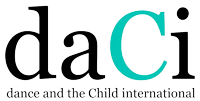History of daCi USA
Promoting dance for children and young people since 1997!

Our Story
In 1978, dance and the Child international was founded. daCi is an autonomous, fully constituted branch of the Conseil International de la Danse, UNESCO, in Paris. Between 1980 and 1997, USA members of daCi international were represented on the board by a representative from the US. National representatives included Peggy Schwartz, Sue Stinson and Sara Lee Gibb. These individuals, as well as Sheryl Shapiro, Maxine DeBruyn and Anne Green Gilbert, were instrumental in increasing daCi membership in the US, and assisted in creating the USA chapter.
In 1997 American members elected a Board of Directors to govern an official chapter. A national constitution was drafted and ratified in April 1999. daCi USA, a 501(c)(3) non-profit organization, provides a structure and a network on the national level for daCi members in the United States.
Our Mission
- To increase and develop opportunities for young people to experience dance as creators, performers, and spectators in the United States
- To ensure that the dance interests of young people are recognized and developed.
- To develop an awareness of cultural diversity.
- To encourage and make available research into all aspects of dance for, with, and related to young people.
- To advocate for the inclusion of dance in both general education and community programs.
- To facilitate exchange and collaboration among members related to dance for young people.

daCi International
Dance and the Child International (daCi) is a nonprofit organization with the aim of promoting the growth and development of dance for children and young people on an international basis.
This association was founded in 1978 at an international conference held at the University of Alberta, Edmonton, Canada. The conference was initiated by Dr. Joyce Boorman and titled "Dance and the Child". The idea was supported and promoted by the National Dance Committee of the Canadian National Association for Health, Physical Education and Recreation. As a result of this successful conference Dance and the Child International was born.
In 1979 the President of the Conseil International de la Danse (CID), UNESCO invited daCi to join. In 1980 daCi became a fully constituted branch of the CID organization.
daCi strives to promote all that can benefit dance and the child and young people, irrespective of race, color, sex, religion, national or social origin. The right of every child and young person to dance and the preservation of the cultural heritage of all forms of dance for children and young people are recognized. In creating opportunities for children and young people to experience dance as performers, creators and spectators, their views and interests are of primary importance. The inclusion of dance in general education and community programs, and the research into all aspects of dance for children and young people are encouraged.
National Representatives sit on the International Advisory Board, from which the Executive Committee is elected. It is the role of the Advisory Board and the Executive Committee to oversee the general operation and procedures of the organization and to maintain communication internationally. More and more countries have national chapters with committees and procedures and maintain programs, conferences and communication with national members.
The mission of daCi is to promote an international network facilitating the development of dance for children throughout the world.